Family
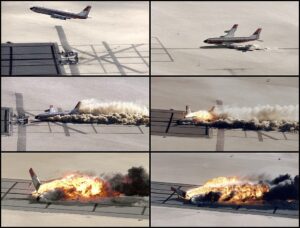 The Controlled Impact Demonstration, also known as “the Crash in the Desert” was a joint project between NASA and the Federal Aviation Administration (FAA). The idea was to intentionally crash a remotely controlled Boeing 720 airplane in order to acquire data and test new technologies to aid passenger and crew survival. As we all know, airplane crashes, often bring fatalities. Still, there have been a number of airplane crashes in which all or most of the plane’s occupants survived the crash. The point of “the crash in the desert” was to learn from the vent, and hopefully make a way for more people to survive the crash.
The Controlled Impact Demonstration, also known as “the Crash in the Desert” was a joint project between NASA and the Federal Aviation Administration (FAA). The idea was to intentionally crash a remotely controlled Boeing 720 airplane in order to acquire data and test new technologies to aid passenger and crew survival. As we all know, airplane crashes, often bring fatalities. Still, there have been a number of airplane crashes in which all or most of the plane’s occupants survived the crash. The point of “the crash in the desert” was to learn from the vent, and hopefully make a way for more people to survive the crash.
The Controlled Impact Demonstration took more than four years of preparation by NASA Ames Research Center, Langley Research Center, Dryden Flight Research Center, the FAA, and General Electric to pull off. Then, because obviously they did not have an unlimited supply of planes, they held several test runs to make sure they had the right “crash” conditions to learn the most about crashes. Finally, on December 1, 1984, the plane was actually crashed. The test went pretty much according to plan and produced a large fireball that required more than an hour to extinguish. With that in mind, a casual observer would assume that everyone would have died, but the FAA concluded that about one-quarter of the passengers would have survived!! It also determined that the antimisting kerosene test fuel did not sufficiently reduce the risk of fire. Antimisting kerosene (AMK) is “a jet fuel containing an antimisting additive. This additive, a high-molecular-weight polymer, causes the fuel to resist atomization and liquid shear forces, which also affect flow characteristics in the engine fuel system.” Finally, it determined that several changes to equipment in the passenger compartment of aircraft were needed…which is probably one of the most important findings of the demonstration. NASA also concluded that a head-up display and microwave landing system would have definitely helped the pilot more safely fly the aircraft.
On the morning of December 1, 1984, the test aircraft took off from Edwards Air Force Base, California. Once aloft, the plane made a left-hand departure and climbed to an altitude of 2,300 feet. The plane was remotely flown by NASA research pilot Fitzhugh Fulton from the NASA Dryden Remotely Controlled Vehicle Facility. All fuel tanks were filled with a total of 76,000 pounds of AMK and all engines ran from start-up to impact. The total flight time was 9 minutes on the modified Jet-A. It then began a descent-to-landing along the roughly 3.8-degree glideslope to a specially prepared runway on the east side of Rogers Dry Lake, with the landing gear remaining retracted.
Passing the decision height of 150 feet above ground level (AGL), the airplane turned slightly to the right of the desired path, entering into a situation known as a Dutch roll. Slightly above that decision point at which the  pilot was to execute a “go-around” maneuver. There appeared to be enough altitude to maneuver back to the center-line of the runway. The aircraft was below the glideslope and below the desired airspeed. At this point, the data acquisition systems had been activated, and the plane was committed to impact. That situation had to have almost a strange feeling to it…that point of knowing that the plane was going to crash and knowing that the crash was exactly what you wanted it to do. Then the plane contacted the ground, left wing low, at full throttle, with its nose pointing to the left of the center-line. The original plan was that “the aircraft would land wings-level, with the throttles set to idle, and exactly on the center-line during the CID, thus allowing the fuselage to remain intact as the wings were sliced open by eight posts cemented into the runway (called “Rhinos” due to the shape of the “horns” welded onto the posts).” The Boeing 720 had a surprise in store for the researchers, when it landed askew. “One of the Rhinos sliced through the number 3 engine, behind the burner can, leaving the engine on the wing pylon, which does not typically happen in an impact of this type. The same rhino then sliced through the fuselage, causing a cabin fire when burning fuel was able to enter the fuselage.”
pilot was to execute a “go-around” maneuver. There appeared to be enough altitude to maneuver back to the center-line of the runway. The aircraft was below the glideslope and below the desired airspeed. At this point, the data acquisition systems had been activated, and the plane was committed to impact. That situation had to have almost a strange feeling to it…that point of knowing that the plane was going to crash and knowing that the crash was exactly what you wanted it to do. Then the plane contacted the ground, left wing low, at full throttle, with its nose pointing to the left of the center-line. The original plan was that “the aircraft would land wings-level, with the throttles set to idle, and exactly on the center-line during the CID, thus allowing the fuselage to remain intact as the wings were sliced open by eight posts cemented into the runway (called “Rhinos” due to the shape of the “horns” welded onto the posts).” The Boeing 720 had a surprise in store for the researchers, when it landed askew. “One of the Rhinos sliced through the number 3 engine, behind the burner can, leaving the engine on the wing pylon, which does not typically happen in an impact of this type. The same rhino then sliced through the fuselage, causing a cabin fire when burning fuel was able to enter the fuselage.”
“The cutting of the number 3 engine and the full-throttle situation was significant, as this was outside the test envelope. The number 3 engine continued to operate for approximately 1/3 of a rotation, degrading the fuel and igniting it after impact, providing a significant heat source. The fire and smoke took over an hour to extinguish. The CID impact was spectacular with a large fireball created by the number 3 engine on the right side, enveloping and burning the aircraft. From the standpoint of AMK the test was a major set-back. For NASA Langley, the data collected on crashworthiness was deemed successful and just as important.”
The actual impact proved that the antimisting additive they had tested was not going to prevent a post-crash fire in all situations, but the reduced intensity of the initial fire was attributed to the effect of the AMK. FAA investigators estimated that 23% to 25% of the aircraft’s full capacity of 113 people could have survived the crash. Now that is saying something, considering the way the crash looked to observers. “Time from slide-out to complete smoke obscuration for the forward cabin was 5 seconds; for the aft cabin, it was 20 seconds. Total time to evacuate was 15 and 33 seconds respectively, accounting for the time necessary to reach and open the doors and operate the slide.” The FAA instituted new flammability standards for seat cushions which required the use of fire-blocking layers as a result of analysis of the crash, resulting in seats which performed better than those in the test. From this crash demonstration, came the implementation of a standard requiring floor 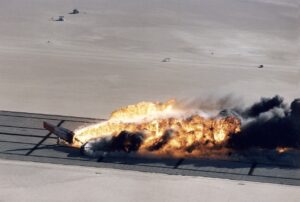 proximity lighting to be mechanically fastened, due to the apparent detachment of two types of adhesive-fastened emergency lights during the impact. In addition, federal aviation regulations for flight data recorder sampling rates for pitch, roll, and acceleration were found to be insufficient. NASA determined that at the point of impact, the piloting task workload unusually high, which might have been reduced through the use of a heads-up display, the automation of more tasks, and a higher-resolution monitor. The use of a microwave landing system to improve tracking accuracy over the standard instrument landing system was also recommended. The Global Positioning System-based Wide Area Augmentation System came to fulfill this role.
proximity lighting to be mechanically fastened, due to the apparent detachment of two types of adhesive-fastened emergency lights during the impact. In addition, federal aviation regulations for flight data recorder sampling rates for pitch, roll, and acceleration were found to be insufficient. NASA determined that at the point of impact, the piloting task workload unusually high, which might have been reduced through the use of a heads-up display, the automation of more tasks, and a higher-resolution monitor. The use of a microwave landing system to improve tracking accuracy over the standard instrument landing system was also recommended. The Global Positioning System-based Wide Area Augmentation System came to fulfill this role.
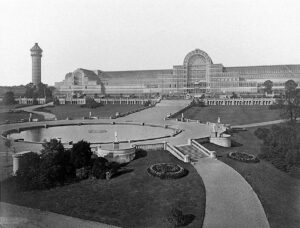
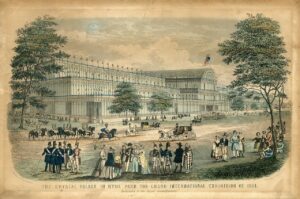 Every time there is a great event like the Olympics, the World’s Fair, or in this case, the Great Exhibition, a stunning new building or structure is built to house the event. The Crystal Palace was originally located in Hyde Park, London, England. It was a cast iron and plate glass structure, built to house the Great Exhibition of 1851. The Great Exhibition took place from May 1 to October 15, 1851, with more than 14,000 exhibitors from around the world gathered in its 990,000 square feet exhibition hall to display their own examples of the latest technology they had developed in the Industrial Revolution. The Crystal Palace was designed by Joseph Paxton. It was 1,851 feet long, with an interior height of 128 feet. It was three times the size of Saint Paul’s Cathedral. Some say that the name of the building came from a piece penned by the playwright Douglas Jerrold, who in July 1850 wrote in the satirical magazine Punch about the forthcoming Great Exhibition, referring to a “palace of very crystal.”
Every time there is a great event like the Olympics, the World’s Fair, or in this case, the Great Exhibition, a stunning new building or structure is built to house the event. The Crystal Palace was originally located in Hyde Park, London, England. It was a cast iron and plate glass structure, built to house the Great Exhibition of 1851. The Great Exhibition took place from May 1 to October 15, 1851, with more than 14,000 exhibitors from around the world gathered in its 990,000 square feet exhibition hall to display their own examples of the latest technology they had developed in the Industrial Revolution. The Crystal Palace was designed by Joseph Paxton. It was 1,851 feet long, with an interior height of 128 feet. It was three times the size of Saint Paul’s Cathedral. Some say that the name of the building came from a piece penned by the playwright Douglas Jerrold, who in July 1850 wrote in the satirical magazine Punch about the forthcoming Great Exhibition, referring to a “palace of very crystal.”
The design called for 60,000 panes of glass to adorn the building. On average, a team of 80 men could fix more than 18,000 panes of sheet glass in a week. These were manufactured by the Chance Brothers. The building was finished in 39 weeks. The Crystal Palace boasted the greatest area of glass ever seen in a building. Visitors were shocked and astonished by all the clear walls and ceilings that did not require interior lights. The interior of the building had full grown trees!! The full-size elm trees that had been growing in the park were simply enclosed within the central exhibition hall near the 27-foot-tall Crystal Fountain. While very nice looking, the trees caused a problem with sparrows becoming a nuisance, and of course, shooting was out of the question inside a glass building. When Queen Victoria mentioned this problem to the Duke of Wellington, he offered the solution, “Sparrowhawks, Ma’am.” Now to me, that is incredulous, because you would simply be replacing on kind of bird with another, and then there was the added problem of bird violence. I don’t think the visitors would be very thrilled about the fighting birds or dropping bodies.
Incredibly, the Palace was relocated after the Great Exhibition, to an open area of South London known as Penge Place which had been excised from Penge Common. The building was rebuilt at the top of Penge Peak next to Sydenham Hill, which is an affluent suburb. The Crystal Palace stood in that location from June 1854 until a fire destroyed it in November 1936. After the fire, the suburb was renamed Crystal Palace after the landmark. In addition, a park was placed in the area and named Crystal Palace Park. It surrounds the site, and is home of the Crystal Palace National Sports Centre, which was previously a football stadium that hosted the FA Cup Final between 1895 and 1914. Crystal Palace Football Club were founded at the site and played at the Cup Final venue in their early years. The site still contains Benjamin Waterhouse Hawkins’s Crystal Palace Dinosaurs which date back to 1854.
In the 1920s, a board of trustees was set up under the guidance of manager Sir Henry Buckland. Buckland was a fair man with a great love for the Crystal Palace, decided to restore the building. Following the restoration, the visitors returned, and the Crystal Palace started to become profitable again. Buckland and his staff also worked on improving the fountains and gardens, including the Thursday evening displays of fireworks by Brocks. Then, on the evening of November 30, 1936, Buckland was walking his dog near the Palace with his daughter Crystal. Buckland had named her after the building. Always looking at the building he loved, they noticed a red glow coming from inside. Buckland went in to investigate and found two of his employees fighting a small office fire that had started after an explosion in the women’s cloakroom. Buckland could see that this was a serious fire, so they called the Penge fire brigade. It was too late. Even with the 89 fire engines and over 400 firemen, the fire was too big and too out of control to be able to extinguish it.
The infamous Crystal Palace was destroyed. The fire was so big that its glow could be seen across eight counties. With high winds that night, the fire spread quickly, and in part because of the dry old timber flooring, and the huge quantity of flammable materials in the building it burned to the ground. Buckland said, “In a few hours we have seen the end of the Crystal Palace. Yet, it will live in the memories not only of Englishmen, but the whole world.” The fire brought one-hundred thousand spectators to Sydenham Hill that night. One of the 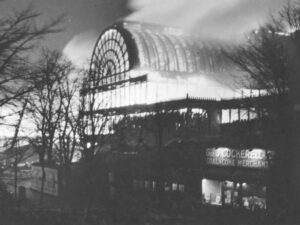
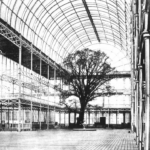 spectators was Winston Churchill, who said, “This is the end of an age.” Unfortunately, as was common for the era, the Crystal Palace was underinsured, and with a potential rebuild cost of at least £2 million, the building was never rebuilt. John Logie Baird, who had used the South Tower and much of the lower level of the building for mechanical television experiments. Much of his work was destroyed in the fire, and Baird suspected the fire was an act of arson to destroy his work on developing television. Nevertheless, the true cause remains unknown.
spectators was Winston Churchill, who said, “This is the end of an age.” Unfortunately, as was common for the era, the Crystal Palace was underinsured, and with a potential rebuild cost of at least £2 million, the building was never rebuilt. John Logie Baird, who had used the South Tower and much of the lower level of the building for mechanical television experiments. Much of his work was destroyed in the fire, and Baird suspected the fire was an act of arson to destroy his work on developing television. Nevertheless, the true cause remains unknown.
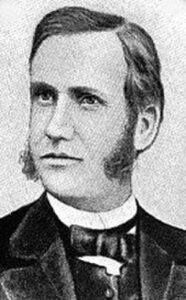
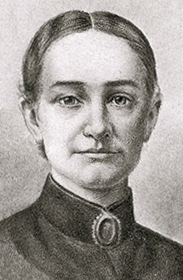 When Marcus and Narcissa Whitman and their family contracted the measles in 1847, little did they know that it would not be measles that would endanger their lives, but the treatment given after they got over the measles. The Whitmans were American missionaries who lived and worked in the area of what is now Walla Walla, Washington. When the measles broke out, the missionaries managed to survive the disease, most likely by using normal medical protocols, but the Cayuse Indians, who lived in the area, and weren’t known for cleanliness, did not fare so well. Of course, there is no proof that it was a lack of cleanliness that caused the deaths, nor was there proof that it did not. The main reason that the Whitman Mission was included in the ensuing massacre is that the Cayuse came to them for help, and lives were lost.
When Marcus and Narcissa Whitman and their family contracted the measles in 1847, little did they know that it would not be measles that would endanger their lives, but the treatment given after they got over the measles. The Whitmans were American missionaries who lived and worked in the area of what is now Walla Walla, Washington. When the measles broke out, the missionaries managed to survive the disease, most likely by using normal medical protocols, but the Cayuse Indians, who lived in the area, and weren’t known for cleanliness, did not fare so well. Of course, there is no proof that it was a lack of cleanliness that caused the deaths, nor was there proof that it did not. The main reason that the Whitman Mission was included in the ensuing massacre is that the Cayuse came to them for help, and lives were lost.
The Whitman massacre, which was also known as the Whitman killings and the Tragedy at Waiilatpu, mostly refers to the killing of American missionaries Marcus and Narcissa Whitman, and eleven others who were involved with the mission, on November 29, 1847. The missionaries were killed by a small group of Cayuse men who accused Whitman of poisoning 200 Cayuse in his medical care during an outbreak of measles that included the Whitman household. The massacre occurred at the Whitman Mission at the junction of the Walla Walla River and Mill Creek in what is now southeastern Washington near Walla Walla. That massacre changed everything in the history of the Pacific Northwest…at least as far as the Oregon Territory was concerned anyway. The massacre caused the United States Congress to take action declaring the territorial status of the Oregon Country, thereby establishing the Oregon Territory on August 14, 1848, to protect the white settlers.
The Cayuse justified the killings by saying that any time a “medicine man” failed to bring about healing to a patient, the medicine man was killed for giving out “bad medicine” to his patients. Basically, the “medicine man” who officiated over a terminal patient, had better plan on going with the patient, because any death was going to be his fault. Basically, the Cayuse looked at Whitman’s failure to cure the Cayuse people as a criminal inability to perform his duties as “medicine man.” Of course, their “findings” were not logical, but they weren’t 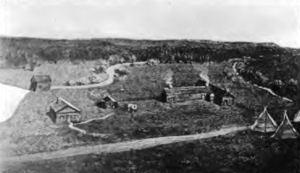 thinking logically and didn’t really care anyway. The warriors were simply acting out of grief and an expectation of revenge for what they believed was a serious injustice against their people. In the White Man’s language, the massacre is usually ascribed to “the inability of Whitman, a physician, to prevent the measles outbreak.” At least three Cayuse villages held Whitman responsible for the widespread epidemic that killed those hundreds of Cayuse people, while leaving the White settlers comparatively unscathed. Some Cayuse people even accused the settlers of poisoning the Cayuse as part of a plan to take their land. Of course, justice needed to be carried out, and in the trial of five Cayuse warriors accused of the killing, the Cayuse used for their defense that it was tribal law to kill the medicine man who gives bad medicine.
thinking logically and didn’t really care anyway. The warriors were simply acting out of grief and an expectation of revenge for what they believed was a serious injustice against their people. In the White Man’s language, the massacre is usually ascribed to “the inability of Whitman, a physician, to prevent the measles outbreak.” At least three Cayuse villages held Whitman responsible for the widespread epidemic that killed those hundreds of Cayuse people, while leaving the White settlers comparatively unscathed. Some Cayuse people even accused the settlers of poisoning the Cayuse as part of a plan to take their land. Of course, justice needed to be carried out, and in the trial of five Cayuse warriors accused of the killing, the Cayuse used for their defense that it was tribal law to kill the medicine man who gives bad medicine.
Everything blew up on November 29, 1847, when Tiloukaikt, Tomahas, Kiamsumpkin, Iaiachalakis, Endoklamin, and Klokomas, who were enraged by Joe Lewis’ talk, attacked Waiilatpu. According to Mary Ann Bridger, the young daughter of mountain man Jim Bridger, who was a lodger of the mission and eyewitness to the event, the men knocked on the Whitmans’ kitchen door and demanded medicine. Bridger went on to say that “Marcus brought the medicine and began a conversation with Tiloukaikt. While Whitman was distracted, Tomahas struck him twice in the head with a hatchet from behind and another man shot him in the neck. The Cayuse men rushed outside and attacked the white men and boys working outdoors.” Whitman’s wife, Narcissa found him fatally wounded, and while he lived for several hours after the attack, and sometimes responded to her anxious reassurances, he later died of his injuries. Catherine Sager, who had been with Narcissa in another room when the attack occurred, later wrote in her reminiscences that “Tiloukaikt chopped the doctor’s face so badly that his features could not be recognized.”
Had she stayed hidden, Narcissa might have lived through the attack, but she later went to the door to look out and was immediately shot by a Cayuse man. Then she was coaxed out of the house. She died from a volley of 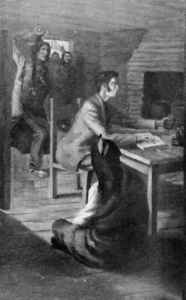
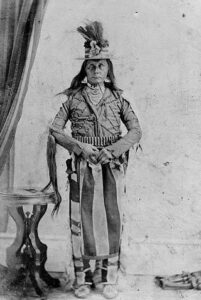 gunshots immediately upon leaving the house. The rest of the people killed in the massacre were Andrew Rodgers, Jacob Hoffman, LW Saunders, Walter Marsh, John and Francis Sager, Nathan Kimball, Isaac Gilliland, James Young, Crocket Bewley, and Amos Sales. A carpenter who had been working on the house, Peter Hall managed to escape the massacre and reach Fort Walla Walla to raise the alarm and get help. After leaving Fort Walla Walla, he left to warn Fort Vancouver, but he never made it. Sone think that Hall drowned in the Columbia River, while others speculate that he was caught and killed. On man, Chief “Beardy” tried to stop the massacre, but it was too out of control. The warriors were insanely crazy with grief, and nothing was going to stop their revenge. Chief “Beardy” was found crying while riding toward the Whitman Mission.
gunshots immediately upon leaving the house. The rest of the people killed in the massacre were Andrew Rodgers, Jacob Hoffman, LW Saunders, Walter Marsh, John and Francis Sager, Nathan Kimball, Isaac Gilliland, James Young, Crocket Bewley, and Amos Sales. A carpenter who had been working on the house, Peter Hall managed to escape the massacre and reach Fort Walla Walla to raise the alarm and get help. After leaving Fort Walla Walla, he left to warn Fort Vancouver, but he never made it. Sone think that Hall drowned in the Columbia River, while others speculate that he was caught and killed. On man, Chief “Beardy” tried to stop the massacre, but it was too out of control. The warriors were insanely crazy with grief, and nothing was going to stop their revenge. Chief “Beardy” was found crying while riding toward the Whitman Mission.
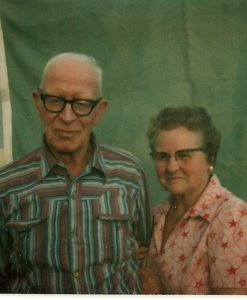
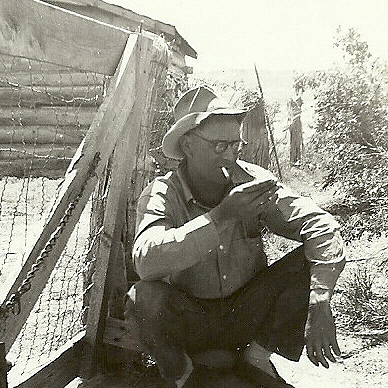 My husband’s grandfather, Robert Knox was a hardworking man all his life. When I first met him, he was already retired, of course. Nevertheless, he was still working hard. Grandpa was the keeper of the vegetable garden. We all benefitted from the vegetable garden, but it was Grandpa who kept the garden. I got involved in some of the harvesting…we all did, but I don’t think Grandpa would have appreciated it if we tried to get out there and “tend” the garden. That was his domain, and you really should stay away from it. Seriously though, Grandpa loved his vegetable garden. It got his outside and kept him busy. He would probably have been bored silly without it…and Grandma would have had to figure out what to do with him if he was bored silly.
My husband’s grandfather, Robert Knox was a hardworking man all his life. When I first met him, he was already retired, of course. Nevertheless, he was still working hard. Grandpa was the keeper of the vegetable garden. We all benefitted from the vegetable garden, but it was Grandpa who kept the garden. I got involved in some of the harvesting…we all did, but I don’t think Grandpa would have appreciated it if we tried to get out there and “tend” the garden. That was his domain, and you really should stay away from it. Seriously though, Grandpa loved his vegetable garden. It got his outside and kept him busy. He would probably have been bored silly without it…and Grandma would have had to figure out what to do with him if he was bored silly.
Grandpa was blessed on his 67th birthday with the coolest birthday gift ever…the birth of his third great granddaughter, Machelle (Cook) Moore. Grandma had been given that blessing with their first great granddaughter, Corrie (Schulenberg) Petersen, and Grandpa really wanted the same gift. A year and 5 months later, he was so blessed…and so happy. Sharing a birthday with a child, grandchild, or great grandchild is something that doesn’t happen for just anyone, so those who are so blessed, usually know just how rare a treat that is. Not very many people get to have that, and to have two in one couple is really rare.
Grandpa loved to read. He had a stack of books that was usually taller than he was. The funny thing was that he would read several at one time, and he could totally keep up with the story line on all of them. Western were his book of choice, which is typical for his era. He was born in 1908, and in during that and they subsequent eras, westerns were pretty much what was out there. I don’t know what he would think of some of the book of 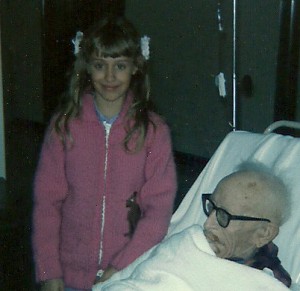
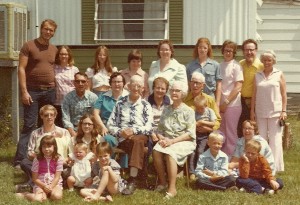 our time, but my guess is that he wouldn’t have liked them very much. I can’t say that I necessarily care much for most of them either. While we were two generations apart, and he probably though I was a silly girl when I first met him when I was just 17 years old, I grew to love that old man. Sadly, he died of cancer in 1985, when he was far too young. He was just 77 years old. Today is the 115th anniversary of Grandpa’s birth. Happy birthday in Heaven, Grandpa Knox. We love and miss you very much.
our time, but my guess is that he wouldn’t have liked them very much. I can’t say that I necessarily care much for most of them either. While we were two generations apart, and he probably though I was a silly girl when I first met him when I was just 17 years old, I grew to love that old man. Sadly, he died of cancer in 1985, when he was far too young. He was just 77 years old. Today is the 115th anniversary of Grandpa’s birth. Happy birthday in Heaven, Grandpa Knox. We love and miss you very much.
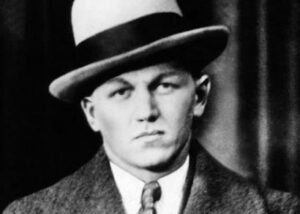 Lester Joseph Gillis may have had a baby face, but he was no innocent. The fact is that he seldom went by his real name. His alias was George Nelson and Baby Face Nelson. While he had a baby face, he was not a nice man, in fact, he was a cold-hearted killer, known for killing more FBI agents than any other criminal. Gillis was born in the Patch area of Chicago, Illinois on December 6, 1908. He was the seventh child of Belgian immigrants, Joseph and Mary Gillis. His father was a hardworking man, who worked in a tannery. Joseph strived to raise a loving family…but, somehow, with Lester, that proper upbringing didn’t work out so well. Lester’s first arrest occurred on July 4, 1921, at the age of twelve. In that incident, he accidentally shot a playmate in the jaw with a pistol that he had found. The situation was serious enough, that he served over a year in the state reformatory. When he got out at age 13, Nelson was quickly arrested again for car theft and joyriding at age 13. He was sent to a correctional school for an additional 18 months and released on April 11, 1924. Gillis’ family was horrified at his behavior, but Gillis was “on a roll” by then, and he didn’t care. He liked the “excitement” that a life of crime provided, and he wasn’t about to quit.
Lester Joseph Gillis may have had a baby face, but he was no innocent. The fact is that he seldom went by his real name. His alias was George Nelson and Baby Face Nelson. While he had a baby face, he was not a nice man, in fact, he was a cold-hearted killer, known for killing more FBI agents than any other criminal. Gillis was born in the Patch area of Chicago, Illinois on December 6, 1908. He was the seventh child of Belgian immigrants, Joseph and Mary Gillis. His father was a hardworking man, who worked in a tannery. Joseph strived to raise a loving family…but, somehow, with Lester, that proper upbringing didn’t work out so well. Lester’s first arrest occurred on July 4, 1921, at the age of twelve. In that incident, he accidentally shot a playmate in the jaw with a pistol that he had found. The situation was serious enough, that he served over a year in the state reformatory. When he got out at age 13, Nelson was quickly arrested again for car theft and joyriding at age 13. He was sent to a correctional school for an additional 18 months and released on April 11, 1924. Gillis’ family was horrified at his behavior, but Gillis was “on a roll” by then, and he didn’t care. He liked the “excitement” that a life of crime provided, and he wasn’t about to quit.
By the time he met his wife, Helen Wawrzyniak, Gillis (Baby Face Nelson) was working at a Standard Oil station in his neighborhood. Of course, that job wasn’t what it seemed either. The station doubled as the headquarters for a group of young tire thieves, known as “strippers” and Nelson fell into association with them. Through that association, Nelson acquainted himself with a number of local criminals. One of those criminals employed him to drive bootleg alcohol throughout the Chicago suburbs. Nelson quickly became a known member of the suburb-based Touhy Gang. All this happened by the time he was in his mid-teens. Very soon he became the Touhy Gang’s leader. In 1928, he married Helen Wawrzyniak, and they had two children, but that didn’t change his “bad boy ways” either. Within two years, Nelson and the gang were involved in organized crime, especially armed robbery. On January 6, 1930, the associates forced entry into the home of magazine executive Charles M Richter. After securing him up with adhesive tape and cutting the phone lines, they ransacked the house and made off with approximately $205,000 worth of jewelry, which would figure to approximately $3.3 million in 2021 dollars. Just two months later, they carried out a similar robbery at the bungalow of Lottie Brenner Von Buelow on Sheridan Road. This job netted approximately $50,000 worth of jewelry. After the crime, Chicago newspapers dubbed the gang, “The Tape Bandits.”
On April 21, 1930, Nelson and his gang robbed a bank for the first time. That take could hardly be considered 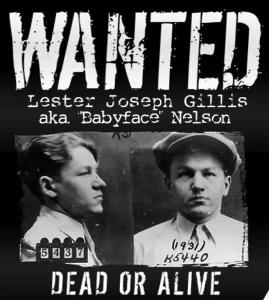 successful, at a mere $4,000. A month later, he and his gang netted $25,000 worth of jewelry from home invasions. On October 3, 1930, Nelson robbed the Itasca State Bank of $4,600…another disappointing take, and an even bigger problem, when a teller later identified him as one of the robbers. Three nights later, he brazenly stole the jewelry of the wife of Chicago mayor Big Bill Thompson, valued at $18,000. She also described her attacker, saying “He had a baby face. He was good looking, hardly more than a boy, had dark hair and was wearing a gray topcoat and a brown felt hat, turned down brim.” The net was beginning to close around Nelson. Then, he and his crew were linked to a botched roadhouse robbery in Summit, Illinois, on November 23, 1930.In the ensuing gunfight, three people were killed and three wounded. One might think that Nelson would lay low for a while, but three nights later, Nelson’s gang robbed a tavern on Waukegan Road, and Nelson committed his first murder, when he fatally shot stockbroker Edwin R Thompson.
successful, at a mere $4,000. A month later, he and his gang netted $25,000 worth of jewelry from home invasions. On October 3, 1930, Nelson robbed the Itasca State Bank of $4,600…another disappointing take, and an even bigger problem, when a teller later identified him as one of the robbers. Three nights later, he brazenly stole the jewelry of the wife of Chicago mayor Big Bill Thompson, valued at $18,000. She also described her attacker, saying “He had a baby face. He was good looking, hardly more than a boy, had dark hair and was wearing a gray topcoat and a brown felt hat, turned down brim.” The net was beginning to close around Nelson. Then, he and his crew were linked to a botched roadhouse robbery in Summit, Illinois, on November 23, 1930.In the ensuing gunfight, three people were killed and three wounded. One might think that Nelson would lay low for a while, but three nights later, Nelson’s gang robbed a tavern on Waukegan Road, and Nelson committed his first murder, when he fatally shot stockbroker Edwin R Thompson.
Throughout the winter of 1931, most of the “Tape Bandits” were rounded up, including Nelson. The Chicago Tribune referred to their leader as “George ‘Baby Face’ Nelson” who received a sentence of one year to life in the state penitentiary at Joliet. Refusing to be held, Nelson escaped during a prison transfer in February 1932. Through his contacts within the Touhy Gang, Nelson fled west to Reno, where he was harbored by William Graham, a known crime boss and gambler. He began using the alias “Jimmy Johnson” at this point. Nelson…now Johnson went to Sausalito, California, where he worked for bootlegger Joe Parente.
Nelson decided that it was time for him to have a gang of his own after the Grand Haven bank robbery. Nelson used his connections at the Green Lantern Tavern in Saint Paul, to recruit Homer Van Meter, Tommy Carroll, and Eddie Green. With his new gang, and with the addition of two other local thieves, Nelson robbed the First National Bank of Brainerd, Minnesota on October 23, 1933. The take on that robbery was $32,000, or approximately $670,000 in 2021 dollars. It was reported that Nelson wildly sprayed sub-machine gun bullets at bystanders to facilitate his getaway. Then, he picked up his wife, Helen and four-year-old son Ronald, and left with his crew for San Antonio, Texas. In San Antonia, he and his gang bought several weapons from a crooked gunsmith Hyman Lehman, one of which was a .38 Super Colt pistol that had been modified, so it was fully automatic. That gun was used by Nelson to kill Special Agent W Carter Baum at Little Bohemia Lodge several months later.
On December 9, 1933, a local woman tipped off San Antonio police regarding “high-powered Northern gangsters” in the area. Tommy Carroll was cornered two days later by two detectives who opened fire, killing Detective H.C. Perrin and wounding Detective Al Hartman. At that point, the gang split up with all the Nelson gang, except Nelson, leaving San Antonio. As a way to distance himself from the gang, Nelson and his wife traveled west to the San Francisco Bay Area. The prior close call didn’t slow him down, however. In San Francisco, he recruited John Paul Chase and Fatso Negri for a new wave of bank robberies the following spring. The next winter found him in Reno, where he met the vacationing, Alvin Karpis. Karpis introduced him to Midwestern bank robber Eddie Bentz. Teaming up with Bentz, Nelson returned to the Midwest the next summer. 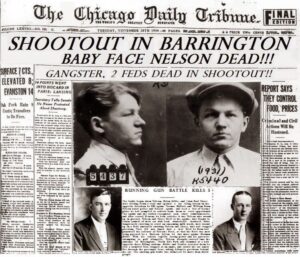 On August 18, 1933, Nelson committed a major bank robbery in Grand Haven, Michigan. It was his first robbery in the area. The robbery was pretty much a failure…but it was a successful failure, because most of those involved made a full escape.
On August 18, 1933, Nelson committed a major bank robbery in Grand Haven, Michigan. It was his first robbery in the area. The robbery was pretty much a failure…but it was a successful failure, because most of those involved made a full escape.
Gillis Helped John Dillinger escape from prison in Crown Point, Indiana, and then became his partner. Nelson and the Touhy Gang were collectively “Public Enemy Number One” by the FBI. The alias, “Baby Face Nelson” came from Gillis being a short man with a youthful appearance. Still, in the professional realm, Gillis’ fellow criminals addressed him as “Jimmy.” On November 27, 1934, FBI agents fatally wounded and killed Baby Face Nelson in the Battle of Barrington, which was fought in a suburb of Chicago, Illinois.
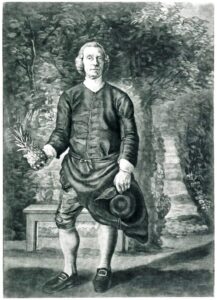 In what is one of the funniest displays of “wealth” the pineapple was once carried around as proof that the one carrying it was a first-class citizen. Now, I can’t say that I think the tradition made any sense, but in 18th century England, pineapples really were a status symbol. Their very cost set the apart as something only owned by the very rich. Like many of the upper-class citizens of that era, they liked to flaunt their wealth to those less fortunate. So, those rich enough to own a pineapple would carry them around to signify their personal wealth and high-class status. They also adorned everything from clothing to houseware with the tropical fruit.
In what is one of the funniest displays of “wealth” the pineapple was once carried around as proof that the one carrying it was a first-class citizen. Now, I can’t say that I think the tradition made any sense, but in 18th century England, pineapples really were a status symbol. Their very cost set the apart as something only owned by the very rich. Like many of the upper-class citizens of that era, they liked to flaunt their wealth to those less fortunate. So, those rich enough to own a pineapple would carry them around to signify their personal wealth and high-class status. They also adorned everything from clothing to houseware with the tropical fruit.
Pineapples were first imported from South America to Europe by Spanish explorers starting in the 16th century. Though native to South America, pineapples made their  way to the Caribbean Island of Guadeloupe. It was in Guadeloupe that Christopher Columbus first spotted their spiky crowns in 1493. He and his crew took the pineapples back to Spain, where everyone loved how sweet this new, exotic fruit tasted. Unfortunately, because they were a tropical fruit, the pineapples wouldn’t grow in Spain. The only pineapples they could get their hands on had to be imported from across the Atlantic. It was time consuming and expensive undertaking, and often resulted in rotten fruit. From Spain, they then came to England. It was in England that the pineapple became the most prestigious fruit of the 18th century. European sailors brought it home as a sign of successful expedition and evidence of their prosperity. It also became a decorative piece on upper-class dining tables. When a pineapple was seen decorating the dining table of a home, you knew that the family had traveled places and
way to the Caribbean Island of Guadeloupe. It was in Guadeloupe that Christopher Columbus first spotted their spiky crowns in 1493. He and his crew took the pineapples back to Spain, where everyone loved how sweet this new, exotic fruit tasted. Unfortunately, because they were a tropical fruit, the pineapples wouldn’t grow in Spain. The only pineapples they could get their hands on had to be imported from across the Atlantic. It was time consuming and expensive undertaking, and often resulted in rotten fruit. From Spain, they then came to England. It was in England that the pineapple became the most prestigious fruit of the 18th century. European sailors brought it home as a sign of successful expedition and evidence of their prosperity. It also became a decorative piece on upper-class dining tables. When a pineapple was seen decorating the dining table of a home, you knew that the family had traveled places and  were either explorers or merchants with money, to afford the exotic fruit.
were either explorers or merchants with money, to afford the exotic fruit.
Because of its new-found fame, the pineapple grew to be very expensive. In the American colonies in the 1700s, pineapples were no less special. They were imported from the Caribbean Islands, and the pineapples that arrived in America were very expensive. In fact, one pineapple could cost as much as $8000…in today’s dollars. While they may have been a symbol of wealth, if you ask me, carrying one around would not be a wise way to show that wealth. It wouldn’t take long for that coveted fruit to go bad, and they all you had was the memory of the money spent and thrown away.
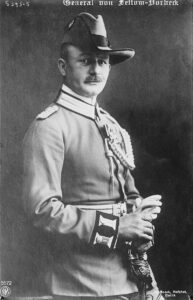
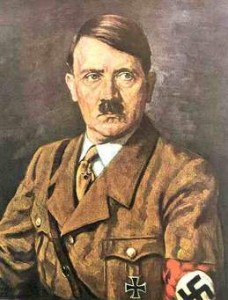 Japan entered World War I as a member of the Allies on August 23, 1914. Assisting the Allies with the war effort was not their reason for doing so, however. Once in, Japan seized the opportunity of Imperial Germany’s distraction with the European War to expand its sphere of influence in China and the Pacific. Because Japan already had a military alliance with Britain, there was minimal fighting as they pushed through to make their territorial gains. Japan was not pressured to enter the war. The Allies had things well in hand, so their motive was obvious. As they swept through, they quickly acquired Germany’s scattered small holdings in the Pacific and on the coast of China. While those holdings were relatively easy to overtake, not all of Germany’s holdings were so easy.
Japan entered World War I as a member of the Allies on August 23, 1914. Assisting the Allies with the war effort was not their reason for doing so, however. Once in, Japan seized the opportunity of Imperial Germany’s distraction with the European War to expand its sphere of influence in China and the Pacific. Because Japan already had a military alliance with Britain, there was minimal fighting as they pushed through to make their territorial gains. Japan was not pressured to enter the war. The Allies had things well in hand, so their motive was obvious. As they swept through, they quickly acquired Germany’s scattered small holdings in the Pacific and on the coast of China. While those holdings were relatively easy to overtake, not all of Germany’s holdings were so easy.
In fact, the other Allies quickly started to realize that Japan’s motives weren’t exactly in everyone’s best interests, and they began to push back hard against Japan’s efforts to dominate China through the Twenty-One Demands of 1915. Japan’s occupation of Siberia against the Bolsheviks failed, as its wartime diplomacy and limited military action produced few results. Then, by the time of the Paris Peace Conference in 1919, Japan was largely frustrated in its ambitions. Nevertheless, Japan had snapped up Germany’s Asian colonies with ease, and even the African colony of Togoland (now Togo and parts of Ghana) fell in less than three weeks. The first real sign of resistance was when German Kamerun (Cameroon) was invaded and lightly contested until 1916. Still, it fell in the end. It seemed that Japan was undefeatable.
Nevertheless, with all the victories, the German colonies in East Africa led by the formidable and undefeated Paul von Lettow-Vorbeck proved to be the exception to the rule. The situation facing von Lettow-Vorbeck and his colonial forces was formidable. Still, von Lettow-Vorbeck knew how to fight, and he refused to back down. When the Japanese came up against von Lettow-Vorbeck, they found themselves heavily outnumbered, and they found themselves with no prospect of reinforcements or much in the way of material support arriving anytime soon.
The fact was that von Lettow-Vorbeck was seeking to tie up British military resources in Africa to relieve some pressure on the European theater. He drew upon his many years of service in Africa to wage a highly effective guerilla war against a much larger enemy. Von Lettow-Vorbeck was probably one of the greatest guerilla warfare strategists of all time…maybe the greatest. Von Lettow-Vorbeck even gained the loyalty of his African soldiers. In those days, it was highly unusual for a commanding officer or any white soldier for that matter, to show any level of respect to the African soldiers. Von Lettow-Vorbeck did, by appointing Black officers and speaking Swahili. The German troops had learned to live off the land and make the most of very little supplies, due to hard lessons drawn from years of colonial warfare in Africa. Those years were filled with atrocities, but they had persevered.
This one small German colonial army tied up the British forces for the duration of the conflict. The British had been plundering food 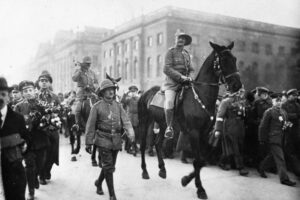 supplies that devastated the local population. Finally, the German army surrendered on November 25, 1918, in Zambia, two weeks after the November 11, 1918 armistice ended hostilities. Of course, Hitler knew a great officer when he saw one, and so after the war, Hitler immediately offered von Lettow-Vorbek a prestigious position in the Third Reich. In what most would consider a complete shock, von Lettow-Vorbeck bluntly refused the offer, using some very “colorful” language, which shall not be repeated here. It was a courageous, but not very wise move, given the circumstances. Nevertheless, his boldness, as well as his loyalty to the German people, paid off. Von Lettow-Vorbeck was simply too popular with the German people to be eliminated by the regime. He lived to be 94.
supplies that devastated the local population. Finally, the German army surrendered on November 25, 1918, in Zambia, two weeks after the November 11, 1918 armistice ended hostilities. Of course, Hitler knew a great officer when he saw one, and so after the war, Hitler immediately offered von Lettow-Vorbek a prestigious position in the Third Reich. In what most would consider a complete shock, von Lettow-Vorbeck bluntly refused the offer, using some very “colorful” language, which shall not be repeated here. It was a courageous, but not very wise move, given the circumstances. Nevertheless, his boldness, as well as his loyalty to the German people, paid off. Von Lettow-Vorbeck was simply too popular with the German people to be eliminated by the regime. He lived to be 94.
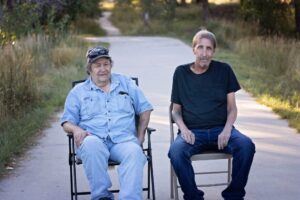 My cousin, Delwin Johnson was always a quiet man…at least he was every time I was around him. Nevertheless, he was a sweet man, and it makes me sad that he has left us. I’m sure that he wasn’t quite so quiet around his family. In fact, he loved teasing his nephew, Ethan Stanko when he kept asking his mom, JeanAnn Stanko to explain the game of football to him on Thanksgiving, but then Ethan was just too busy to listen to his mom teach him about the game. It’s a typical kid thing, but funny, nevertheless. As for Del’s brother, Elmer…well, they were very close, and there will always be a hole in Elmer’s life where his little brother once was. That makes me so sad, because I know Elmer missed Del so much.
My cousin, Delwin Johnson was always a quiet man…at least he was every time I was around him. Nevertheless, he was a sweet man, and it makes me sad that he has left us. I’m sure that he wasn’t quite so quiet around his family. In fact, he loved teasing his nephew, Ethan Stanko when he kept asking his mom, JeanAnn Stanko to explain the game of football to him on Thanksgiving, but then Ethan was just too busy to listen to his mom teach him about the game. It’s a typical kid thing, but funny, nevertheless. As for Del’s brother, Elmer…well, they were very close, and there will always be a hole in Elmer’s life where his little brother once was. That makes me so sad, because I know Elmer missed Del so much. 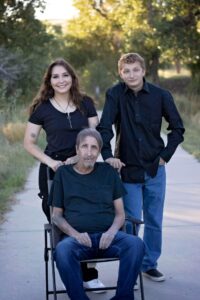
Delwin, wasn’t a clumsy sort, but he did have a “little mishap” one time while he was out hunting with his sister, Darla Stanko. His niece, JeanAnn Stanko tells me, “He was with mom (his sister, Darla Stanko). They stopped because they saw a deer and he accidentally shot through the floorboards, hitting the transmission cooling lines. As you know transmission fluid is red, so it looked like the car was bleeding.” I can see the shock on their faces now, and then, I can almost hear Delwin saying, “Oops, I shot the car!!” Then, the shock would most likely turn to hysterical laughter…until it came time to figure out how to get home…and how to get the car fixed.
Ashley McCollum calls Delwin, Uncle Del, not because he is her biological uncle, but because her dad and Del were friends before Ashley was born. Ashley grew up around Del, and she said that Del had a profound impact on her life. When Ashley was in 7th grade, she was living with Del in a little house on Durbin Street in Casper, and their favorite thing to do was to take turns playing Zelda on Del’s Super Nintendo. They  loved to take their fishing trips. He also helped Ashley and her dad when they needed a new roof on their house. And there was the time Del fed Angel (who I assume was a dog) the last of his pizza. Ashley says you would just have to be to understand, and that she will forever miss her Uncle Del.
loved to take their fishing trips. He also helped Ashley and her dad when they needed a new roof on their house. And there was the time Del fed Angel (who I assume was a dog) the last of his pizza. Ashley says you would just have to be to understand, and that she will forever miss her Uncle Del.
Rachel Johnson, Del’s daughter-in-law recalls the trips she and his son, Jason took to see Del, over the 4th of July. Del’s grandson, JJ had such a wonderful time. He and Grandpa Delwin loved playing with the Nerf guns. Every time JJ managed to hit Del in the chest, Del acted the part of a man who had been shot. JJ loved it!! He laughed and laughed. JJ loved his grandpa so much, and after they had visited, he asked to go see Grandpa Delwin for weeks and weeks. Del loved being a grandpa, and the grandkids and step grandkids were his pride and joy. They are the blessing you get from being a parent. Delwin passed away in exactly the way he wanted to…peacefully in his sleep. We will all miss him very much. Rest in peace Del…until we all meet again.

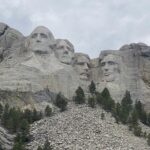 Thanksgiving…a day of reflection on the events of the year that has passed and the blessings we have been given. Many people think of Thanksgiving as just a day to eat a big meal, and watch the parade or a football game, but that isn’t its real purpose at all. None of us goes through life without trials and troubles, but by the grace of God, we have come through another year, and that is something to be thankful for, even if your year had very few trials.
Thanksgiving…a day of reflection on the events of the year that has passed and the blessings we have been given. Many people think of Thanksgiving as just a day to eat a big meal, and watch the parade or a football game, but that isn’t its real purpose at all. None of us goes through life without trials and troubles, but by the grace of God, we have come through another year, and that is something to be thankful for, even if your year had very few trials.
We have been very blessed this past year. Our daughter, Corrie Petersen graduated from nursing school, and we got to go to Las Vegas for her graduation ceremony and spend a week there celebrating. We had a wedding for Athena and Josh, and anniversary for Karen and Chris, and two new great grandsons, Axel and Cyler arrive…to join the great granddaughter, Cambree (who started Kindergarten this year) and two great grandsons, Caysen and Justin, that we already had. My daughter, Amy and her daughter, Shai came out from Washington for the wedding. I also got to go out and spend two wonderful weeks with Amy and her family, Travis, Shai, and Caalab in Washington state. Amy and Shai changed jobs, moving from Rice Insurance to Brown and Brown Insurance. Amy and Travis also got to finally take their anniversary cruise to Alaska. They had a great time, and even got to see the Aurora Borealis. 
 It was a good move for them. Bob and I spent a relaxing week in the Black Hills, as well as our anniversary trip to Thermopolis, which are two of our favorite places.
It was a good move for them. Bob and I spent a relaxing week in the Black Hills, as well as our anniversary trip to Thermopolis, which are two of our favorite places.
As with any year, there were a few tougher times, but they were few and far between. All in all, our year was awesome, and we can honestly say that God has greatly blessed our family. As we celebrate the blessings of God, I want to give thanks to Him who is the Father of all blessings. We would not be where we are without our gracious God. We have been healed of all our infirmities and strengthened for all we have undertaken. Our God is truly an awesome God!! I pray that everyone had a year filled with God’s greatest blessings. Happy Thanksgiving to all of my family and friends! God bless your next year! I love you all!
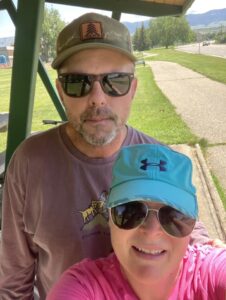
 My niece, Kelli Schulenberg is one of the all-time greatest country music fans in the world…well, maybe that is a bit of an exaggeration, but she certainly is a big fan. Kelli loves going to concerts and I recently found out that she blogs about the concerts she attends and any other little tidbits she finds out about the various bands. Kelli’s blog is called “Thoughts From A Gypsy Soul.” I’m looking forward to reading about her adventures.
My niece, Kelli Schulenberg is one of the all-time greatest country music fans in the world…well, maybe that is a bit of an exaggeration, but she certainly is a big fan. Kelli loves going to concerts and I recently found out that she blogs about the concerts she attends and any other little tidbits she finds out about the various bands. Kelli’s blog is called “Thoughts From A Gypsy Soul.” I’m looking forward to reading about her adventures.
Kelli is wife to my nephew, Barry Schulenberg and “fur mommy” to their dog, Scout. They love to go hiking and bicycling as much as possible. Those things aren’t always easy in Wyoming, so in the winter, they like to go snowshoeing and  cross-country skiing. They really love camping in the summertime, and in fact, the mountains could easily be their favorite place in the world…other than at a concert, of course. One of their favorite places to go is the Big Horn Mountains, which is a favorite for most Wyoming campers. Kelli and Barry live in the country, east of Casper, Wyoming, and their place has an incredible view of our own Casper Mountain. Their favorite thing to do, when they can’t be up on Casper Mountain hiking and camping, is to be out in their yard relaxing and looking at Casper Mountain.
cross-country skiing. They really love camping in the summertime, and in fact, the mountains could easily be their favorite place in the world…other than at a concert, of course. One of their favorite places to go is the Big Horn Mountains, which is a favorite for most Wyoming campers. Kelli and Barry live in the country, east of Casper, Wyoming, and their place has an incredible view of our own Casper Mountain. Their favorite thing to do, when they can’t be up on Casper Mountain hiking and camping, is to be out in their yard relaxing and looking at Casper Mountain.
Kelli moved to Wyoming from Reading, Michigan, and while she loves summertime in Wyoming, found the winters to be a bit of a culture shock. Nevertheless, she also found her husband Barry, and that he has turned her into a Wyoming girl, even if she is technically a transplant. She still loves going home for visits, often with her mom, Mary Wages, who divides her time between Casper, and Colorado…with occasional 
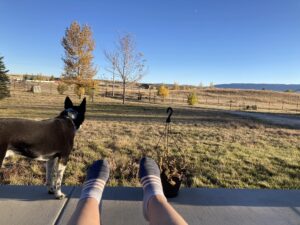 mother/daughter trips back home. Kelli will always consider Michigan to be her home. I think everyone does consider the place of their birth to be home forever, a fact I can attest to. It doesn’t matter how long or how short your time was there…you will always have a place in your heart for the place of your birth. Coming from Wisconsin, I can totally attest to that. For Kelli, Michigan will always be that place in her heart. Today is Kelli birthday. Happy birthday Kelli!! Have a great day!! We love you!!
mother/daughter trips back home. Kelli will always consider Michigan to be her home. I think everyone does consider the place of their birth to be home forever, a fact I can attest to. It doesn’t matter how long or how short your time was there…you will always have a place in your heart for the place of your birth. Coming from Wisconsin, I can totally attest to that. For Kelli, Michigan will always be that place in her heart. Today is Kelli birthday. Happy birthday Kelli!! Have a great day!! We love you!!

